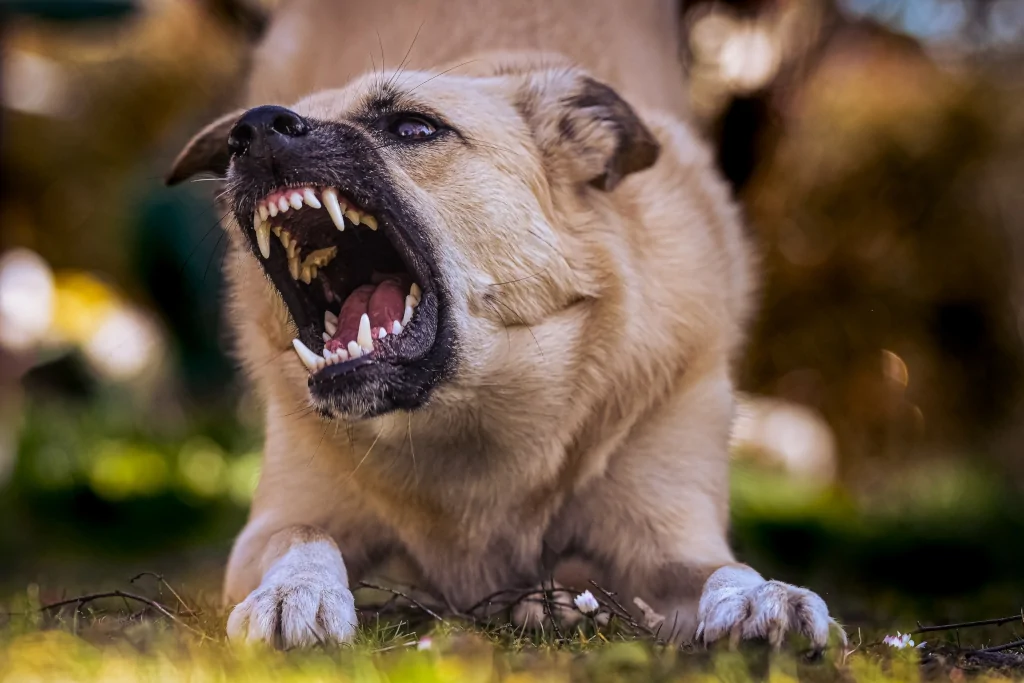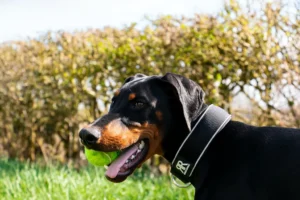Picture this: you’re enjoying a peaceful stroll with your beloved dog, when suddenly, they transform into a snarling, lunging ball of fury.
You’re left puzzled, embarrassed, and worried about your once-tranquil companion.
The truth is, aggression in dogs can be as confusing as it is concerning for pet owners like yourself. Worry no more, for we’ve got you covered with a comprehensive guide on helping you with this issue.
Together, we’ll uncover the reasons behind their aggressive behavior, identify the signs, and delve into practical strategies to prevent and manage it. We’ll help you and your beloved dog find harmony once more.

Why Do Dogs Become Aggressive?
Aggression in dogs can be a result of various factors, from their genetic predisposition to environmental influences. Often, it’s a mix of both.
For instance, a dog might have a genetic predisposition to be wary, but an early experience with an aggressive dog in the park could solidify that wariness into full-blown aggression.
Key triggers include fear, frustration, pain, and territorial instincts. Sometimes, a dog the cause can be separation anxiety. In this case, aggression is caused by fear.
Remember that our companions are not inherently “bad” or “vicious”. They’re simply trying to communicate their needs, discomfort, or perceived threats. Much like how we’d teach kids to handle complex emotions, teaching dogs to process their feelings can be the cornerstone of knowing how to prevent aggression in dogs.
Understanding the root cause of your dog’s aggression is the first step in addressing the issue and ultimately fostering a happier, safer bond with your canine companion.
What Are the Different Types of Dog Aggression?
Dog aggression comes in various forms, and recognizing the specific type is crucial for effective management. Here are some common categories:
- Fear-based aggression. Dogs may act aggressively when they feel cornered, threatened, or scared.
- Territorial aggression. This type of aggression arises when a dog perceives an intrusion into their domain, whether it’s their home or a favorite spot.
- Resource guarding. Dogs might display aggression when protecting valuable resources like food, toys, or even their human family members.
- Pain-induced aggression. A dog in pain may become irritable and snap or bite when touched or approached.
- Social aggression. This occurs when a dog feels threatened by other dogs or people in social situations, often due to inadequate socialization or past negative experiences.
By identifying the type of aggression your dog exhibits, you’ll be better equipped to address their unique needs and create a tailored action plan.
As a practical step, once you’ve pinpointed the aggression type, label it. Having a specific name for it, like ‘Fear of Tall Men’ or ‘Food Guarding’, can help when discussing with family or trainers and serves as a constant reminder of the specific trigger to watch out.
Stay tuned as we delve deeper into understanding and managing your dog’s aggressive behavior.
How Can You Identify the Signs of Aggression in Your Dog?
Detecting early signs of aggression in your dog can make all the difference in preventing unwanted behavior and ensuring a safe environment for everyone involved. Here are some common indicators of aggression to watch for:
- Body language. A dog’s body language can reveal a lot about their emotional state. Stiffening of the body, raised hackles, bared teeth, or a lowered head are all warning signs that your dog may be feeling aggressive. Taking photos or videos with your phone during these episodes can be a valuable tool when used as a reference with behaviorists or vets.
- Growling and snarling. These vocalizations are clear indicators that your dog is uncomfortable or threatened. Don’t punish your dog for growling, as it is their way of communicating their unease. Instead, try to identify and address the root cause.
- Lunging and snapping. If your dog lunges or snaps without making contact, it’s likely a warning that they’re ready to escalate their aggressive behavior if necessary.
- Biting. Biting can range from inhibited nips to more forceful bites. This is the most dangerous form of aggression and requires immediate attention.
Take note of these signs and the specific situations in which they occur to better understand your dog’s aggression triggers. Keeping a journal of these instances can be incredibly helpful in tracking patterns and identifying potential stressors. This practice is especially useful when you’re trying to discern patterns, pinpoint triggers, and learn how to prevent aggression in dogs through early intervention.
Remember that it’s crucial to intervene early when you notice these signs, to prevent the aggressive behavior from escalating.
Creating distance between your dog and the perceived threat, using positive reinforcement techniques, and consistently working on obedience training can help mitigate aggression and foster a more secure and trusting relationship between you and your dog.

What Can You Do to Prevent Aggression in Your Dog?
Taking proactive steps to prevent aggression in your dog is essential for maintaining a safe and loving relationship. Here are some key strategies to help you and your furry friend on this journey.
Proper Socialization
Introducing your dog to new experiences, people, and other animals in a positive and controlled manner is crucial for building their confidence and reducing the likelihood of aggressive behavior.
Begin socialization as early as possible, ideally during their puppy years.
If you have an adult dog, it’s never too late to start. For those adopting adult dogs, find calm and well-adjusted dog ‘role models’ in your community. Their stable behavior can help model the right reactions for your dog, teaching them how to interact safely and confidently.
Consistent Training
Obedience training is an excellent way to establish trust, communication, and a strong bond between you and your dog. Use positive reinforcement techniques, like praise and treats, to reward good behavior. When they behave, reward them. When they misbehave, don’t.
Consistency is key, so make sure all family members are on board and using the same commands and methods.
Understanding and Addressing the Underlying Cause
A crucial part of preventing aggression is understanding the root cause of the behavior. Once you’ve identified the trigger, you can develop a tailored plan to address it.
For example, if your dog is aggressive due to fear, you might work on desensitization and counter-conditioning techniques to help them feel more at ease in triggering situations.
Creating a Safe Environment
Ensure your dog has a designated safe space, like a crate or a separate room, where they can retreat when feeling stressed or overwhelmed.
Additionally, providing ample mental and physical stimulation with regular exercise and interactive toys can help reduce the chances of aggression stemming from boredom or pent-up energy.
Monitoring Health and Well-being
Sometimes, aggression can be linked to underlying medical issues or pain. Regular vet checkups and monitoring your dog’s overall health can help you identify and address any health-related aggression triggers.
By implementing these strategies, you’ll be well on your way to preventing aggressive behavior in your dog and nurturing a harmonious relationship built on trust and understanding.

How to Effectively Manage Aggressive Behavior?
Managing aggressive behavior in your dog can be challenging, but with patience, consistency, and the right approach, you can help them overcome these tendencies. Here are some practical tips to guide you through the process:
- Stay calm and composed. Your dog can pick up on your emotions, so maintaining a calm demeanor is essential. Take deep breaths and avoid raising your voice or showing frustration, as this can escalate the situation.
- Redirect their energy. When you spot the early signs of aggression, redirect your dog’s focus to a more positive outlet, such as a favorite toy or a command they’re good at. This helps diffuse the tension and reinforces desirable behavior.
- Reinforce boundaries. Set clear boundaries for your dog and establish rules for behavior. Consistently reinforce these boundaries using positive reinforcement techniques, like praise and rewards.
- Desensitization and counter-conditioning. Gradually expose your dog to the triggers of their aggression in a controlled environment, while pairing the experience with positive reinforcements. This process helps your dog create new, positive associations with the trigger, reducing their aggressive response over time.
- Avoid punishment. Punishing aggressive behavior can backfire and reinforce the negative emotions your dog associates with the trigger. Instead, focus on rewarding positive behavior and redirecting them when they display aggression.
- Seek professional help. If your dog’s aggressive behavior is severe or persists despite your best efforts, it’s time to consult a professional dog behaviorist or trainer. They can provide tailored guidance and support for you and your dog.
By consistently applying these strategies, you can help manage your dog’s aggressive behavior and foster a safer, more harmonious bond with your canine companion.
When Is It Time to Consult a Professional Behaviorist?
Recognizing when it’s time to seek the help of a professional behaviorist is crucial for your dog’s well-being and your peace of mind.
Some signs that it’s time to consult an expert include persistent or escalating aggressive behavior, a sudden change in your dog’s temperament, or if you feel overwhelmed and unequipped to handle the situation.
A professional behaviorist can provide personalized guidance and support, helping you to better understand your dog’s needs and develop a tailored plan to address the issue.
For instance, a friend of mine consulted a behaviorist when her usually gentle dog began growling and snapping at visitors. With the expert’s help, she discovered an underlying medical issue that was causing her dog’s discomfort and aggression, which was successfully addressed.
If you feel overwhelmed or unable to solve the issue, you may need help, but if you haven’t tried any of the obedience training and socialization, be sure to try that first.
I’m a sucker for certain Cesar Millan techniques, so here’s a great video showcasing dog aggression and how to deal with it:
FAQs
Can aggressive dogs be retrained?
Aggressive dogs can often be retrained through consistent behavior modification techniques, positive reinforcement, and addressing the underlying triggers. However, the success of retraining depends on factors such as the dog’s age, temperament, and the severity of the aggression.
Is it possible for a dog to be aggressive only to certain people or animals?
Yes, dogs can display selective aggression toward specific people or animals due to factors such as past negative experiences, lack of socialization, or certain behavioral triggers.
Can certain breeds be more prone to aggression?
While some breeds may have a genetic predisposition to certain behaviors, aggression is influenced by various factors, including environment, upbringing, and individual temperament. Proper socialization, training, and care can help reduce aggression in any breed.
How can I protect myself and others from an aggressive dog?
To protect yourself and others from an aggressive dog, maintain a safe distance, avoid direct eye contact, and refrain from sudden movements. If you’re the owner, work on addressing your dog’s aggression triggers and consult a professional behaviorist if necessary.
Alex, a passionate animal lover, has experience in training and understanding animal behavior. As a proud pet parent to two dogs and three cats, he founded AnimalReport.net to share insights from animal experts and expand his knowledge of the animal kingdom.




